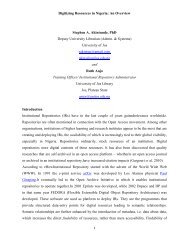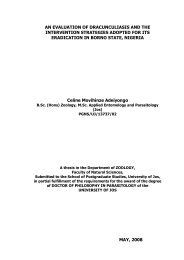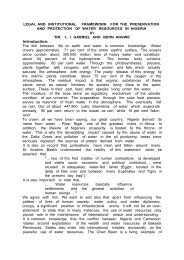Professor Atiene Solomon Sagay - University of Jos Institutional ...
Professor Atiene Solomon Sagay - University of Jos Institutional ...
Professor Atiene Solomon Sagay - University of Jos Institutional ...
Create successful ePaper yourself
Turn your PDF publications into a flip-book with our unique Google optimized e-Paper software.
Known as recurrent pregnancy loss, repeated miscarriage is difficult for both partners<br />
involved. It can also make fertility treatments particularly challenging.<br />
Recurrent pregnancy loss occurs when a women loses three or more consecutive pregnancies.<br />
The majority <strong>of</strong> recurrent pregnancy losses occur early in pregnancy, typically during the first<br />
half <strong>of</strong> pregnancy. Recurrent pregnancy loss is very difficult for couples to experience,<br />
especially because a cause for these miscarriages is <strong>of</strong>ten never determined. Nevertheless, by<br />
undergoing specific fertility testing and treatment, there is hope that couples who have<br />
experienced multiple miscarriages will go on to welcome a healthy child <strong>of</strong> their own.<br />
Fortunately, recurrent pregnancy loss is relatively rare as fewer than 3% <strong>of</strong> couples go<br />
through more than three miscarriages in a row. It is more likely to occur in older women who<br />
have had two previous pregnancy losses and engaged in certain life-styles such as smoking,<br />
heavy drinking and drug use.<br />
Unfortunately, it is difficult to pinpoint the underlying cause <strong>of</strong> pregnancy loss. In fact, more<br />
than 50% <strong>of</strong> couples that experience the problem never find out what is responsible for their<br />
miscarriages. However, there are a number <strong>of</strong> conditions that do underlie some cases <strong>of</strong><br />
recurrent miscarriage. They include genetic factors, structural uterine problems, hormonal<br />
imbalance and blood clotting disorders.<br />
2. What if a pregnancy is unintended and unwanted?<br />
Each year, thousands <strong>of</strong> Nigerian women have unintended pregnancies that end in illegal<br />
abortion. Many <strong>of</strong> such procedures occur under unsafe conditions, contributing to maternal<br />
morbidity and mortality. To highlight this challenge, permit me to share an experience<br />
during my residency training.<br />
It was about 9.00pm on a cold April night in mid-1980s, I was on my first call duty as a<br />
resident doctor in the <strong>Jos</strong> university teaching hospital, <strong>Jos</strong>, and I was asked to review and<br />
admit a young lady who was said to be having vaginal bleeding. She was a university<br />
undergraduate. On the couch, I found a pretty, young lady with a stylish hair do, who was<br />
very pale, cold, motionless and stiff. My examination confirmed that she was dead. I tried to<br />
conceal my horror and politely told the porter to take her back to the casualty <strong>of</strong>ficer and<br />
demonstrated to him that she was brought in dead and could not be admitted to the<br />
gynaecology ward. The brief history suggested that she had a termination <strong>of</strong> pregnancy<br />
somewhere in town that evening. That night, as I reflected on the scene, I realised I had just<br />
witnessed an avoidable maternal death. This experience remained on my mind all through my<br />
residency training and served as a constant reminder <strong>of</strong> how hazardous being a woman in<br />
Nigeria can be.<br />
Abortion in Nigeria is illegal except to save a woman‘s life. Of the estimated 6.8 million<br />
pregnancies that occur annually in Nigeria, one in five is unplanned and half <strong>of</strong> these end in<br />
an induced abortion. (Guttmacher Institute 2008) Abortion is therefore common in Nigeria<br />
and most procedures are performed under unsafe, clandestine conditions. In 1996, an<br />
estimated 610,000 abortions occurred (25 per 1000 women <strong>of</strong> childbearing age), <strong>of</strong> which<br />
142,000 resulted in complications severe enough to require hospitalization. The number <strong>of</strong><br />
abortions is estimated to have risen to 760,000 in 2006 (Bankole et al. 2006). Unsafe<br />
abortions are a major reason Nigeria‘s maternal mortality ratio – 1,100 deaths per 100,000<br />
live births- is one <strong>of</strong> the highest in the world (WHO 2007). According to conservative<br />
4













